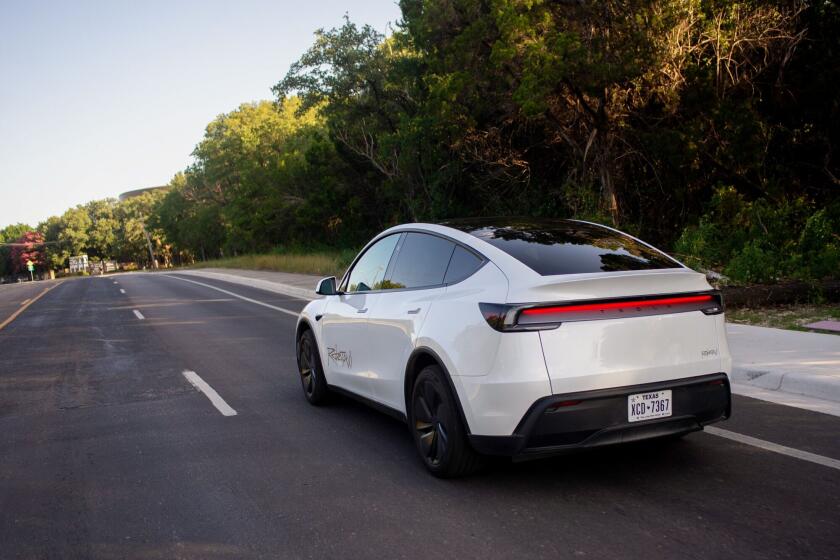Navy Plans Test Flight to Ease Noise Concerns : Oxnard: The military proposes flying jets within a mile of houses and within 100 feet above the sea in checks of anti-aircraft weapons.
- Share via
As part of a plan to begin flying military jets one mile from beach houses, the Navy plans a test flight today near Silver Strand in Oxnard to quiet residents’ fears of deafening noise and possible accidents.
Navy officials said they expect the 2 p.m. flight demonstration to draw dozens of residents, public officials and federal aviation regulators.
“We’re trying to prove it’s not as bad as everybody thinks it might be,” said Cmdr. Steven Rose, a Navy liaison to the Federal Aviation Administration. Navy jets in Ventura County are currently limited to the air space around Point Mugu Naval Air Weapons Station south of Oxnard.
But now a division at the Port Hueneme Navy base wants to fly jets to test anti-aircraft weapons systems.
Port Hueneme’s Naval Surface Warfare Center is proposing to fly high-powered jets as close as 100 feet above the waters of Port Hueneme Harbor and within one mile of Silver Strand’s beachfront homes.
Taking off from Point Mugu, the jets would head west over the ocean before turning northeast and zooming straight toward Silver Strand and Port Hueneme base.
At one mile from shore, the aircraft would make a U-turn, heading back to sea and to Point Mugu for landing, Rose said.
If approved by the FAA, the Navy would fly the jets any time between 10 a.m. and 10 p.m. for 1 1/2-hour periods up to 30 hours a month. Navy officials say that planes would fly for no more than a total of 12 hours most months.
But Rose said the Navy plans for most of the flights to use Lear jets flying at roughly the same speeds as commercial airlines, Rose said.
“The Lear is going to be so quiet probably no one is even going to know it’s there,” he said. “It’s a quiet, quiet aircraft.”
But 10% to 20% of the flights would be by F-14 Tomahawk or F/A-18 Hornet fighter jets at speeds of 350 to 550 knots--a third faster than typical commercial planes.
“Those will be noisy,” Rose said.
Navy officials stressed, however, that none of the jets would fly closer than one mile from the Silver Strand beachfront community.
And because of the distance, Rose said, the whine from the fighter jets would be no louder to residents than the sounds of street traffic.
But some residents said any more noise would be too much.
Earl Beck, 58, a retired computer marketer who has lived in Silver Strand 12 years, said he and his neighbors are already annoyed at helicopter flights over their area.
“If this is going to be additional noise, then we’ve got a problem,” he said.
And resident Bob Launius, 36, said he’s concerned the jets will disturb not only neighbors but also boaters who sail out of nearby Channel Islands Harbor.
“I don’t want to have to deal with the noise at all,” he said. “This is a total residential neighborhood. If they want to do any low-level flyovers, why don’t they do it over Point Mugu? The people that live there volunteered to put up with that type of stuff because they live on a Navy base.”
As for the many residents and tourists who enjoy recreational boating in the waters off Port Hueneme Harbor, Launius said: “The quality of life will go down immensely with some jet screaming over you when you’re out sailing.”
But Gordon Clark, port captain for the Channel Islands Yacht Club north of Silver Strand, said residents and boaters should be willing to put up with some inconvenience because the Navy’s development of weapons systems are in the national interest.
“There’s going to be some noise,” Clark said. “But we do have to pay a price for our freedom.” And Pete Becker, project engineer for the Naval Surface Warfare Center, said the Navy would give 24 hours notice to local marinas and harbors prior to every flight.
If boats were in the waters at a time when jets were to conduct low-level flights, the Navy would cancel the tests that day rather than risk accidents, Becker said.
Navy officials said the flight tests would save taxpayers $13 million a year.
The Naval Surface Warfare Center now tests the sophisticated radar and weapon systems that it develops aboard ships at sea.
If the jet flights are approved, the Navy would save the expense of the shipboard experiments.
Instead, Navy engineers would test the sophisticated radar equipment on base by tracking and targeting the jets as if they were enemy missiles bound for Port Hueneme.
“The aircraft are simulating cruise missiles flying into a self-defense system,” Rose said.
But Launius said he’s concerned that even if the flights prove to be more annoying than expected, residents will have little recourse with the Navy for limiting or halting the tests.
“Once this gets started, it gets very hard to stop,” he said.
More to Read
Sign up for Essential California
The most important California stories and recommendations in your inbox every morning.
You may occasionally receive promotional content from the Los Angeles Times.













